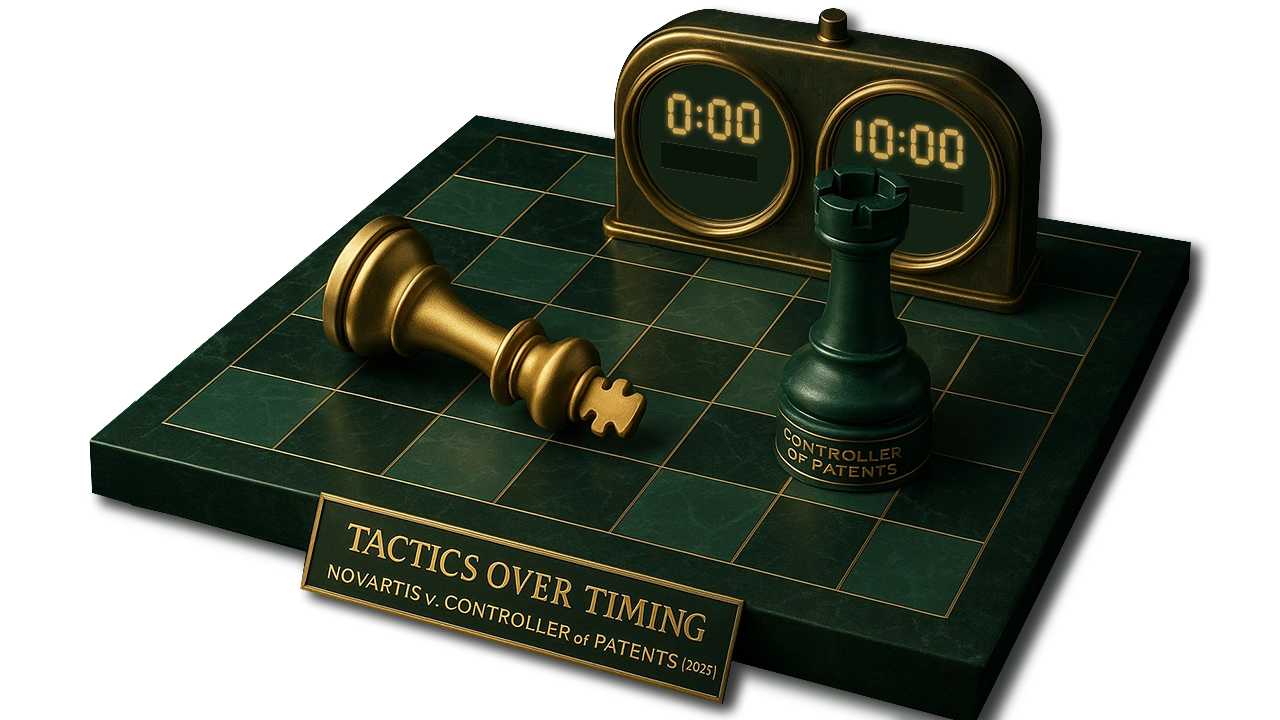Introduction
The Novartis v. Controller of Patents1 is a landmark judgment that dramatically reshapes the landscape of patent litigation in India. It serves as a powerful cautionary tale, demonstrating how a strategic delay, intended to gain a tactical advantage, can be re-framed by the judiciary as a procedural abuse, leading to the forfeiture of crucial rights. The Delhi High Court’s ruling, which denied Novartis’s request for cross-examination, was not based on the merits of its patent but on the company’s conduct during the proceedings. This decision is a fascinating study of the collision between a litigant’s tactical choices and the court’s overarching need for expeditious and fair dispute resolution.
The controversy began when Novartis faced post-grant opposition to its patent for the drug Entresto. The opposition, led by several generic pharmaceutical companies, argued that the patent lacked an inventive step and violated Section 3(d) of the Patents Act, 1970, a provision designed to prevent the “evergreening” of patents. Instead of immediately exercising its right to cross-examine the opponents’ experts, Novartis chose a different path. For an entire year, it focused on filing its own rebuttal evidence, consistently raising objections about the admissibility of the opponents’ evidence without formally challenging its credibility through cross-examination. The critical turning point came in July 2025, the very day the Opposition Board was set to issue its recommendations. It was then, and only then, that Novartis filed an application to cross-examine the experts. This timing was seen by the court as a transparent attempt to stall the proceedings, an impression reinforced by Novartis’s subsequent refusal to attend hearings until its request was granted.
The Judicial Scrutiny: A Question of Conduct, Not Merit
The Delhi High Court, in its judgment, meticulously dismantled Novartis’s arguments. The court’s reasoning rested on several key legal principles. It rejected Novartis’s claim that the necessity for cross-examination arose only after it had filed its rebuttal evidence. It argued that the grounds for challenging the evidence were apparent from the beginning. By pursuing a strategy of rebuttal for a year, Novartis had made a conscious election. The court held that, having made that choice, Novartis was now estopped from changing course. This principle prevents litigants from taking inconsistent positions to gain an unfair advantage, a concept deeply rooted in Indian law, including Section 115 of the Indian Evidence Act, 1872. While Novartis relied on the precedent set in Onyx Therapeutics v. Union of India2, the court distinguished the cases. In Onyx, the patentee had sought cross-examination at the earliest opportunity and consistently reiterated its request, demonstrating a clear intent to use the right legitimately. In contrast, Novartis’s year-long silence and sudden application were seen as a tactical move, not a genuine effort to uphold its rights in a timely manner. The court clarified that the right exists, but it is not a tool for dilatory tactics. Finally, Novartis’s claim that its right to a fair hearing was violated was labeled “complete hogwash” by the court. The court reasoned that natural justice does not entitle a party to every procedural request, especially when sought for tactical reasons. It had already given Novartis a full opportunity to present its case through detailed rebuttal evidence. By refusing to attend the final hearing, Novartis was seen as disrespecting the legal process and attempting to abuse the very principle it was invoking.
Reinforcing a Judicial Trend: The Broader Implications
This decision is not an isolated event; it is a clear manifestation of a growing judicial trend. The principles applied in this case resonate with the rulings in other significant judgments. UCB Farchim v. Cipla Ltd3. (2013) condemned the use of “serial oppositions” as a clear abuse of process to delay patent grants, establishing that procedural mechanisms cannot be misused for tactical gain. The Novartis court’s finding of a “disrespectful” abuse of process directly echoes this sentiment. The Supreme Court’s ruling in F. Hoffmann-La Roche Ltd. v. Cipla Ltd4., which emphasized the paramount importance of expeditious resolution in high-stakes patent matters, also underpinned the Novartis court’s refusal to reward the company’s delay. Furthermore, the Crystal Crop Protection Ltd. v. Safex Chemicals India Ltd5. (2025) judgment, which applied prosecution history estoppel, prevented a patentee from “approbating and reprobating” by taking inconsistent positions during litigation. This concept directly parallels the Novartis court’s finding that the company could not change its strategy after having pursued a different path for a year. In conclusion, the Novartis judgment serves as a powerful cautionary tale, demonstrating that in an environment of growing judicial intolerance for procedural abuse, even the most sophisticated legal strategies can backfire significantly if they undermine the integrity and efficiency of the legal process. The principles of conscious election, estoppel, and a re-evaluated scope of natural justice are now firmly established as judicial tools to curb procedural abuse in India’s dynamic IP landscape.
Conclusion
The judgment is a landmark decision in the Indian intellectual property landscape, and its implications extend far beyond this single case. It serves as a powerful cautionary tale, demonstrating that procedural rights are not absolute and that their exercise is governed by a fundamental expectation of good faith and diligence. By penalising the patent holder for its “strategic silence” and treating its year-long delay as a deliberate waiver of its rights, the Delhi High Court has sent a clear message: the legal system is a forum for genuine dispute resolution, not a playground for tactical gamesmanship. This decision solidifies a growing judicial trend that prioritizes the expeditious disposal of cases, a shift that is crucial for a country seeking to streamline its commercial and intellectual property jurisprudence. As a result, litigants can no longer assume that the legal process will bend to their strategic whims. The principles of conscious election and estoppel now stand as firm judicial tools to curb procedural abuse. The question that remains, however, is whether this new judicial rigor will effectively deter future attempts at strategic delay, or if it will simply force litigants to devise even more sophisticated, and less detectable, tactics.
CItations
- Novartis v. Controller of Patents W.P.(C)-IPD 50/2025 & CM 209-210/2025
- Onyx Therapeutics v. Union of India AIRONLINE 2019 DEL 1349
- UCB Farchim v. Cipla Ltd. (MANU/DE/0297/2010)]
- F. Hoffmann-La Roche Ltd. v. Cipla Ltd. CS (OS) No.89/2008 and C.C. 52/2008
- Crystal Crop Protection Limited v. Safex Chemicals India Limited & Ors CS(COMM)-196/2024
Expositor(s): Adv. Archana Shukla






